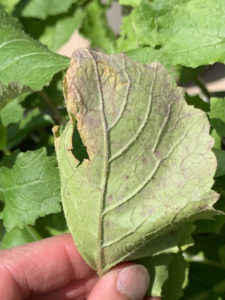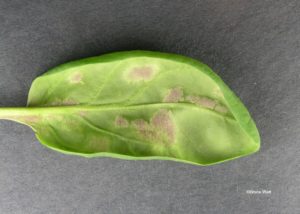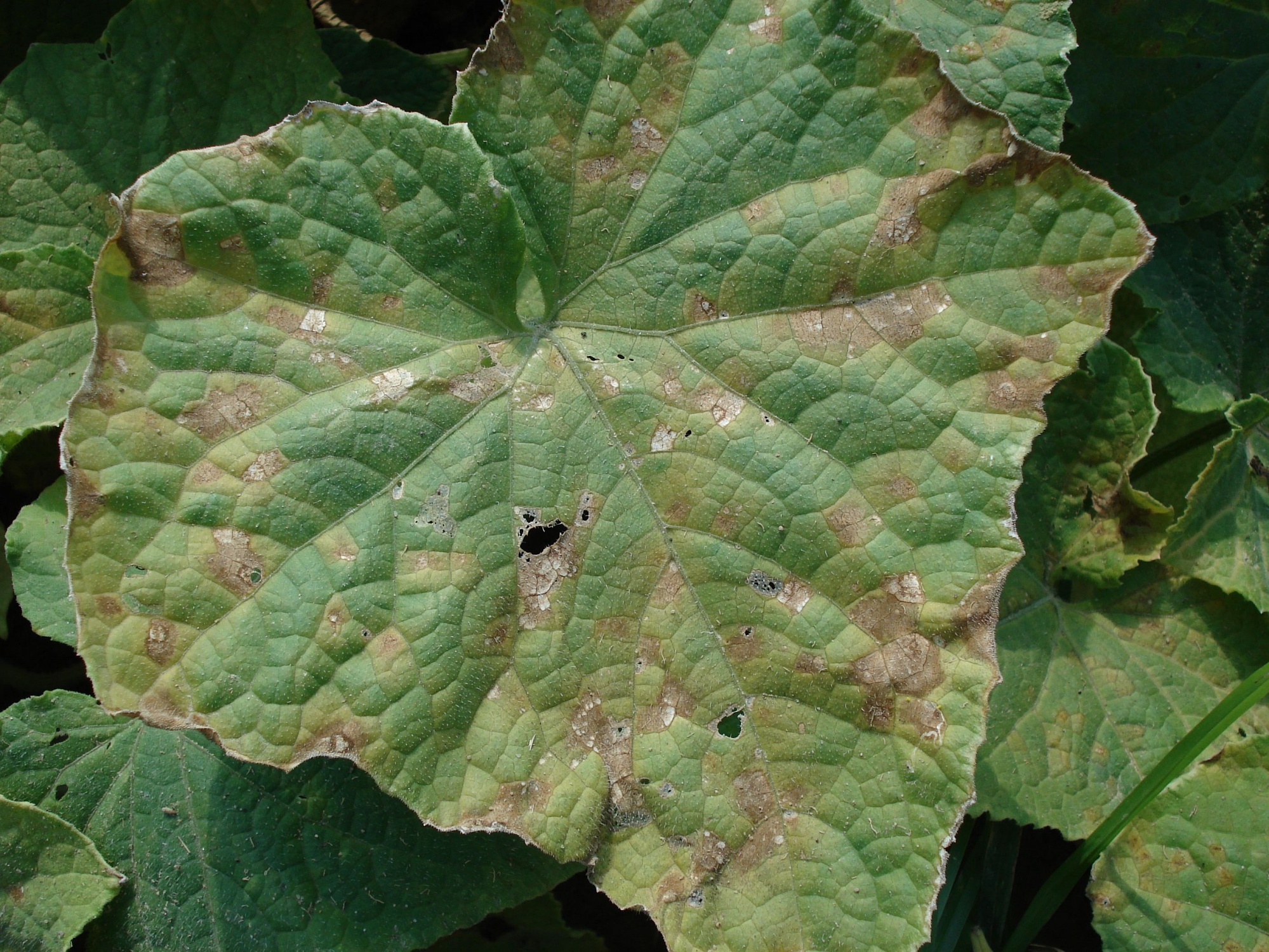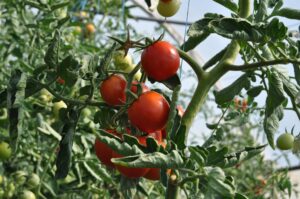Downy mildew is a fungus-like pathogen that appears in gardens in the spring and fall when wet, cool conditions are present. Often confused with powdery mildew, which is a true fungus, downy mildew is a parasitic organism classified as an oomycete or a water mold. Not surprisingly, downy mold, as the condition is also known, is more closely related to algae than fungi because both require moisture to live.
There are several hundred strains of downy mildew. Thus, the host specific parasites can infect a wide range of plants, including broccoli, turnips, Brussels sprouts, grapes, basil, spinach, cucumbers, squash, watermelon, lettuce, and ornamentals like sunflowers, pansies, impatiens, and roses.

How to Identify Downy Mildew
The first signs of downy mildew to appear will be spots located on the underside of older leaves. As the organism grows, downy white patches with a gray, blue, or purple tint will develop. In the meantime, the tops of the leaves will develop white to yellow patches that may turn brown and become brittle.
Powdery mildew is different from downy mildew in that it is characterized by white powdery spores that form first on the upper side of leaves and eventually spread to the entire plant.
How it Spreads
Downy mildew spores can be spread by the wind and rain, making it difficult to completely isolate the disease. The spores live in the soil and remain dormant until a host plant and hospitable conditions become available. When water, whether it is from rain or overhead irrigation, splashes onto the soil, the spores are transferred to the leaves, where they will affix themselves to the underside and begin to multiply.
Spores can also migrate via water on plant tissue, creating a new infection site on other portions of the plant. Infected leaves will also release additional spores that will spread. New spores form in about four to ten days, depending on the conditions.
The spores can also be spread via garden tools and gloves that have come into contact with an infected plant.
Downy mildew can overwinter in the soil or plant debris and, like other organisms, can adapt over time.

Damage It Causes
All parts of the plant can be infected with downy mildew, including flowers and fruit. Affected foliage will wilt, curl, die, and eventually fall off. The plant’s growth will be stunted, and if not treated early, the plant will eventually die.
Seedlings are also vulnerable to the pathogen and will wilt and die. This is a similar outcome to the oomycetes that cause damping off or Fusarium wilt .
This article contains affiliate links. If you make a purchase using one of these links, I will receive a very small commission at no additional cost to you, and it will help me maintain this website. Rest assured, I only recommend products I actually like!
Downy Mildew Treatment
Even though downy mildew isn’t a true fungus, it is treated in the same manner because of the way the organism spreads. It is important to begin treatment as soon as signs first appear so as to thwart its spread.
Pure, 100% cold-pressed neem oil, with the naturally occurring compound called Azadirachtin, can be helpful in prohibiting the spores from spreading. To make your own spray, mix 1 to 2 teaspoons of neem oil with 1/2 to 1 teaspoon of a Castile soap like Dr. Bonner’s and 1 quart of lukewarm water in a sprayer. Shake well. Do a test spray on one leaf and wait 24-48 hours. If there is an adverse reaction, dilute the spray and retest. Apply the spray to all surfaces of the plant, especially the underside of leaves. Repeat once a week as needed. Unfortunately, it will not be as effective once the pathogen has infected the plant’s stem.

Some report the use of baking soda to be a way to slow the organism’s growth. To make your own spray, add 1 tablespoon of baking soda and one quart of water to a spray bottle and mix well. Do a test spray on one leaf and wait 24-48 hours. If there is no noticeable damage, spray the entire plant, including the tops and underside of the leaves. Spray in the early in the morning.
Others recommend the use of 3% hydrogen peroxide. Add 3/4 of a cup to one gallon of water in a pump sprayer. Do a test spray on one leaf wait 24-48 hours. If there is no noticeable damage, spray the entire plant, including the tops and underside of the leaves. Spray in the early in the morning.
Other options include copper fungicides, however, these often contain copper sulfates, which, although classified as organic and said to be safe for garden use, can be toxic to humans, animals, and honeybees.[1] The Genetic Literacy Project reports:
It has been assumed for years that pesticides that occur naturally (in certain plants, for example) are somehow better for us and the environment than those that have been created by man. As more research is done into their toxicity, however, this simply isn’t true, either. Many natural pesticides have been found to be potential – or serious – health risks.[2]
In addition, copper based fungicides are also not guaranteed to remove downy mildew and may not be effective against certain strains. Thus, in my opinion, I would refrain from using this fungicide in my garden.
It is important to understand that none of the treatments listed above are curative. The goal is to slow the progression and spread of the pathogen. There are additional measures you can take to minimize the risk of infection, however.

How to Prevent It
Here is a list of things you can do to help prevent downy mildew from taking hold in your garden:
- Plant varieties that are resistant to downy mildew.
- Water in the morning to give the leaves time to dry before nightfall, or use drip irrigation or soaker hoses to reduce the splash effect.
- Add a layer of mulch to lessen spores’ ability to splash onto plants.
- Wash all tools and anything else that comes into contact with an infected plant. You can use rubbing alcohol or a bleach solution made up of 1 part bleach to 9 parts water. (You can learn about more disinfecting options in this helpful article.)
- Routinely inspect the underside of leaves for early detection.
- Remove damaged leaves and plant debris, especially if you think it may be harboring spores from infected plants
- Remove and destroy plants that are infected and cannot be returned to health. Do not compost as most compost piles are not hot enough to kill these pathogens.
- Prune plants to allow for greater airflow
- Prune plants so that low hanging branches, leaves, and fruit are not touching the soil.
- Space plants at proper distances from one another to increase air circulation.
- Practice crop rotation.
- Do not reuse potting mix or soil that contained an infected plant as the spores can remain in the soil for up to five years.
No one wants to see downy mildew in their garden, but there are ways to manage the problem. Early detection and treatment are the keys to stopping the spread of this pathogen.
To learn more about the difference between downy mildew and powdery mildew, click here.
Thank you for reading this article! If you found it helpful, please consider sharing it with others via email and on social media!
[1]Andrew Porterfield, “Organic Fungicide Copper Sulfate Poses Dangers to Humans, Animals, Insects—How Does It Compare to Conventional Pesticides?” Genetic Literacy Project, 11-16-18, accessed 7-7-20,
[2] Ibid.



